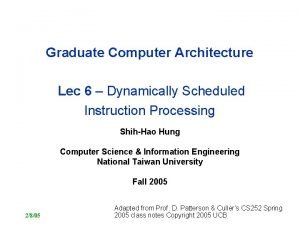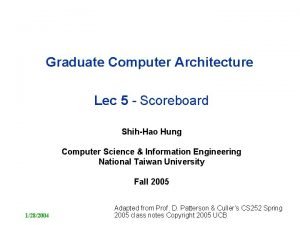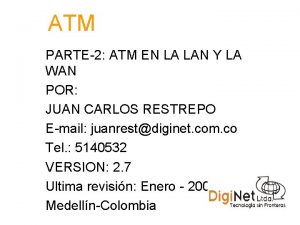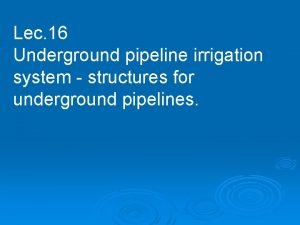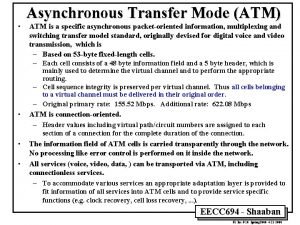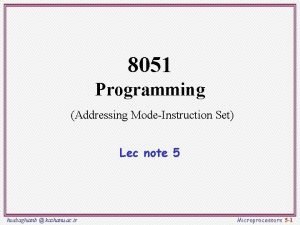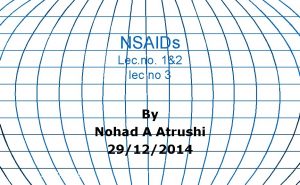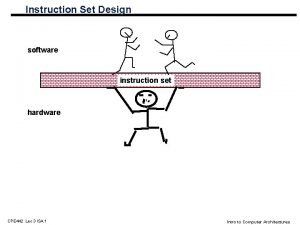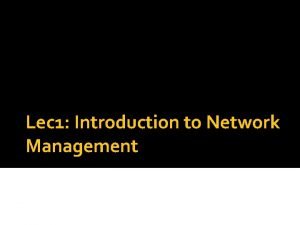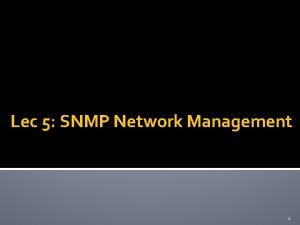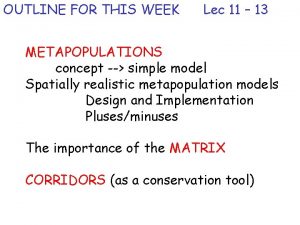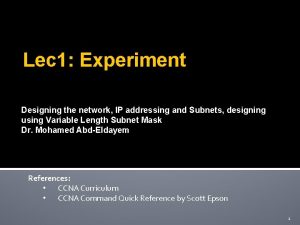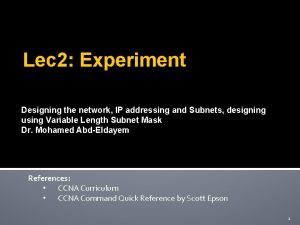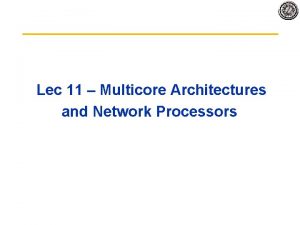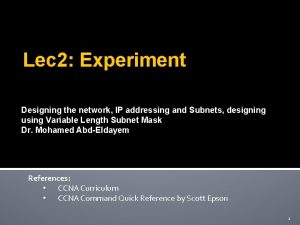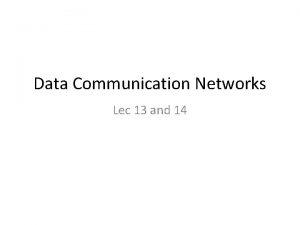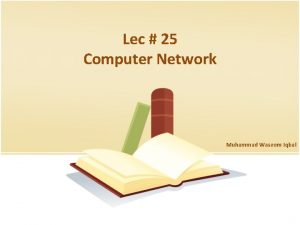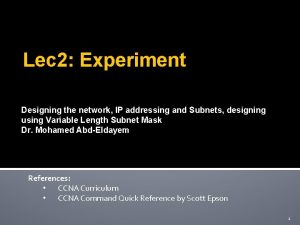Lec 3 Network Management Outline Network Management Network






























- Slides: 30

Lec 3: Network Management

Outline � Network Management � Network Administrators Jobs � Reasons for using Network Management Systems � Analysing Network Data � Points that must be taken into account when managing networks � Benefits of using networks that works full time (7 days X 24 hours) � Steps for Preventive Management (Before the failure occur) � Warnings Classification “Reactions” to Network Management � Components for Network Management System � Reasons for the success of the (SNMP) network management program � What is ISO? � Functions of Network Management based of ISO Model � Additional Main functions for Network management based on ISO model 2

Definition of Management �Management in general means: 1. To manage. 2. To control. 3. To guide. 4. To treat with care 5. To carry on business 6. To achieve goals 3

Network Management � Network Management: It is an approach for managing and controlling network to get the best performance, productivity and availability. � This method in management includes assigning permissions, monitoring errors, configuring network, monitoring users and devices, and connection method. 4

Network Management � According to International Telecommunication Union (ITU) definition of network management this includes the following tasks: Monitoring and controlling network performance during real or actual work in the network (Operation) Doing necessary work to control network directly when it is required. Improving bandwidth usage Planning for future requirements (development) Business continuity plan (risks) 5

Network Administrators Jobs 1. 2. 3. 4. 5. 6. Meeting users needs. Adding network services to improve performance. Effective operation of network to get the best availability with the least percentage of errors. Fast response. Using different techniques. Managing different sites. 6

Reasons for using Network Management Systems 1) 2) 3) 4) 5) 6) 7) 8) The existence of modern and important techniques in the field of information technology (IT): a) Bank Networks. b) Electronic government. c) Connecting users (the client & the seller) The great expansion of networks Promising benefits of networks (Cost – effective). Improving modern techniques in networking field. Applying different techniques on one network. Reducing the efforts of using large number of specialists & technicians to monitor the network. Improving network performance. Improving the security of information. 7

Analyzing Network Data 1. What are the kind of information exchanged: data – audio – video – image. 2. Who needs to use the different kind of information available online. 3. The level of security required in the network. 4. Priority of the required information. 5. Scalability. 8

Points that must be taken into account when managing networks 1. Availability. 2. Users cost. 3. Reporting errors. 4. Determining problems and their solutions. 5. Backup and contingency plan. 6. Performance monitor. 7. Maintenance tools. 9

Benefits of using networks that works full time (7 days X 24 hours) � Saving time because of using networks at any time. � Saving data transfer � Quality and accuracy � Higher productivity � Great benefits compared to the costs (the benefits ratio is higher than the loss ratio) � Great reputation for the organization that owns the network. 10

Steps for Preventive Management (Before the failure occur) A. B. C. Exploring the current state of the network 1) What are the devices connected to the network currently? 2) How to configure these devices? 3) What are the current performances of these devices? 4) What are the current errors? Network Activation 1) Determining the route 2) Changing network configuration 3) Replacing network devices 4) Getting previous information about the network 5) Performing statistical analysis to the information. Future Expectation: 1) Where failure could happen? 2) Monitoring sensitive devices 3) Overcoming future mistakes 11

Steps for Preventive Management (Before the failure occur) D. E. Tracking Updates on the Network 1) Current state of the devices 2) Topography changes 3) Discovering new devices Adding Alerts 1) CPU performance 2) Capacity of storage devices 3) Line mistakes. 4) Connection devices failures 5) Important events on the network 12

Warnings Classification “Reactions” to Network Management Inactive 1. Does not monitor the network Ignore all alerts Reactive 2. Does not monitor the network React to the problems after it happens Interactive 3. Monitor the network’s components Analyze the problem to avoid alerts and determine the reason for the problem Proactive 4. Monitor the network’s components Determines the reasons for the problem Solve the problem automatically to reduce idle time of the system Idle Time of the system : refers to the time when system stops working. 13

Components for Network Management System 1. 2. 3. 4. 5. 6. Devices, Applications and routers. Network management administrator. Network Management Systems. Workstations and network tools. Alerts and reports. User Interface. 14

Reasons for the success of the (SNMP) network management program Possibility to get the standards for free. Possibility to get the standards from websites in the form of electronic templates. 3. The continuous development of the standards. 4. Explain the need for some functions through the use of experimental models. 1. 2. 15

What is ISO? �Abbreviation of International Organization for Standardization (ISO) �It is an independent international organization to set standards established at 1947 �Its main responsibility specialized to set standards in the field of computing and communication. �Its members are from deferent local organizations from different countries. 16

Functions of Network Management based of ISO Model A. B. C. D. E. Fault Management Accounting Management Configuration Management Security Management Performance Management 17

A. Fault Management � It is a way to determine, restrict and discover faults in the network. � Main functions of fault management: � 1. 2. 3. 4. 5. 6. 7. Monitoring the network status. Crash management. Restricting faults. Troubleshooting faults. Testing from the beginning to the end. Performing backups. Grouping and saving all alerts in a log file. Remedy: www. Remedy. com Seugate: www. Seugate. com Example: 18

Flow Chart for Fault Management Alert Open the Fault Note Problem No No Yes Is the problem solved? Analyzing problem and finding the solution Applying solution Is the solution for the problem known Yes Finding Reasons Close the Fault Note 19

B. Accounting Management �Accounting management is a method for determining: How users (groups or single) access network resources? Make sure for the suitable way to access network resources. Counting the cost for accessing resources by users (groups or single) 20

Main Functions for Accounting Management Pricing. Making sure of the bills of the dealers and suppliers. 3. Network usage. 4. Restoring strategy when the performance decrease. 5. Measuring the usage of network resources so that we can calculate the benefits from these resources. Example: www. cbis. com 1. 2. 21

C. Configuration Management �It is a way for determining, monitoring and modifying the setup of devices. �Main functions for configuration management 1. Processing services requests. 2. Monitoring modification management. 3. The status of network topology and storage devices. 4. Storage management and restoring information. � Example: www. openview. hp. com Cisco work 22

D. Security Management It is a way for controlling the access to network resources (update – allow access – don’t allow access – alert) � Main functions for security management: � 1. 2. 3. 4. 5. 6. Setting access lists on routers (fire walls) so that passwords are maintained and updated regularly to access critical resources in the network. Controlling access to network resources based on internal instructions so that no one ruin information intentionally or unintentionally. Monitoring users and how they use network resources. Determining critical network resources including systems and files. Monitoring access points to critical network resources. Analyzing risks and reviewing the security of the network. Example: Checkpoint - lucent 23

E. Performance Management Measuring the network resources usage, and it is a way to measure the performance of all network components. � Main functions for performance management: � 1. 2. 3. 4. 5. 6. Measuring performance (connection – load of the network) Monitoring performance (the delay in responding to a request) Determining the highest level of performance. Analyzing performance. Using standards to improve network performance. Using simulation system to plan for future improvements on network performance. Example: www. proactivenet. com www. ganymede. com 24

Specification of Network Management Architecture Gathering information & variable & giving it to the network administrator Analyzing data & information to set the highest performance level Determining access permissions and boundaries that should not be crossed 25

Additional Main functions for Network management based on ISO model A. Capacity Planning Management B. Strategic Planning Management C. Operation Support Management D. Programmability Management 26

A. Capacity Planning Management 1. Accurate setting of network regularly. 2. Software updates such as (adding or removing technologies. 27

B. Strategic Planning Management 1. 2. 3. 4. 5. Part of the management plan where new applications are managed & rearranged. Benefits & expected cost. Emergency plan. Future planning for improving applications. Future improvement for network to keep up improvement for performance, users , and applications. 28

C. Operation Support Management 1. Managing employees and technicians in their training and needs and job position. 2. Managing network resources. 3. Maintenance management. 4. Managing information flow & all network events. 29

D. Programmability Management �Organizing management systems to match with network management in the term of system features, reports and other choices. 30
 Scoreboard computer architecture
Scoreboard computer architecture 11th chemistry thermodynamics lec 13
11th chemistry thermodynamics lec 13 Lec ditto
Lec ditto Scoreboarding computer architecture
Scoreboarding computer architecture Componentes del lec
Componentes del lec 11th chemistry thermodynamics lec 10
11th chemistry thermodynamics lec 10 Lec elements
Lec elements August lec 250
August lec 250 Lec 16
Lec 16 Lec material
Lec material Apelacin
Apelacin Lec
Lec 132000 lec
132000 lec Ir.ac.kashanu.register://h
Ir.ac.kashanu.register://h Tura analítica
Tura analítica Sekisui slec
Sekisui slec 416 lec
416 lec Lec
Lec Brayton
Brayton Lec promotion
Lec promotion Lec anatomia
Lec anatomia History of software development life cycle
History of software development life cycle Lec arg
Lec arg Lecsl
Lecsl Lec hardver
Lec hardver Lec renal
Lec renal 252 lec
252 lec Quote sandwich
Quote sandwich Lynx browser
Lynx browser Knowledge management course outline
Knowledge management course outline Bsb51407
Bsb51407


